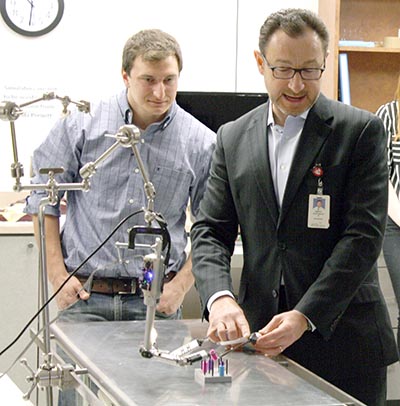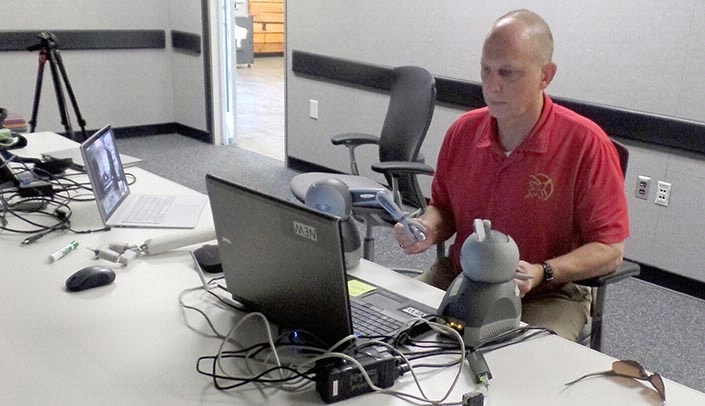Two Nebraska robotics researchers hope that, one day, astronauts will use their miniature robots to conduct surgery in space.
On May 23, they came a step closer to that aim when retired U.S. astronaut Clayton Anderson took the controls while at the Johnson Space Center in Houston, directing a robot to perform tasks at a facility at the University of Nebraska Medical Center.
 |
UNMC’s Dimitry Oleynikov, M.D., holds a laparoscopic tool similar to what is used now in surgery to compare size to the robot. He’s helping to keep the peg board secure while Clayton Anderson does the peg transfer. Behind Dr. Oleynikov is Lou Cubrich, a graduate research assistant at the University of Nebraska-Lincoln. |
Dmitry Oleynikov, M.D., a professor of surgery at UNMC, and Shane Farritor, Ph.D., an engineering professor at the University of Nebraska-Lincoln, have been developing advanced miniaturized robots that are inserted into the body to perform abdominal surgery.
Some of their work has been funded by NASA Johnson Space Center and the NASA Nebraska Space Grant with an aim of producing robots that could be used for medical procedures in space. Drs. Farritor and Oleynikov also formed Virtual Incision, a university-based start-up company, to commercialize their work.
Dr. Farritor was at Anderson’s side in Houston, while Dr. Oleynikov supervised activities at the Center for Advanced Surgical Technology at UNMC in Omaha.
“Here at the UNMC Center for Advanced Surgical Technology we are always seeking ways to innovate and our partnership with Dr. Farritor has afforded us those opportunities,” said Dr. Oleynikov, director of the center. “The ability to operate a robot from afar or to program a robot to do surgical procedures with little prompting seems to be a concept far into the future. The demonstration we did with Clayton Anderson proves that we are getting one step closer to that future. The possibilities and applications could be endless.”
Dr. Farritor said the long-term goal is to conduct surgery in remote locations and to be able to have intelligence in the robots that would allow surgery to be performed by non-surgeons. More than 60 robot prototypes have been produced and extensively tested in bench-top studies, NASA Extreme Environment Mission Operations, and a parabolic flight.
A Virtual Incision robot was used last year to perform a colon resection in human patients in Paraguay.
Unlike large, mainframe-like robots that reach into the body from outside the patient, the system used in Paraguay features a small, self-contained surgical robot that is inserted through an incision in the patient’s belly button. It avoids the large open incision involved with many surgical procedures today.
